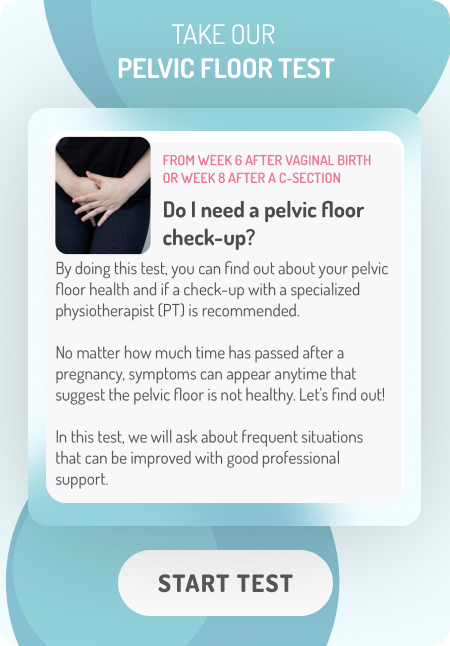
Do you need a pelvic floor checkup?
Let’s talk about the pelvic floor and why pelvic floor health after pregnancy is so important for women. Do you experience urine leaks when you cough or sneeze? Do you feel pain during sex with penetration? Do you have hemorrhoids? All of these, and more, can be symptoms of your pelvic floor not being in good condition.
For too long, it has been thought that urine leaks or pain during intercourse, for example, are the price women pay for being a mother or getting older. But this is just a myth. The vast majority of these conditions can be resolved, or at least greatly improved, with the correct treatment.
But first, what is the pelvic floor?
The pelvic floor is the set of muscles and ligaments in the trunk’s lower part. It is shaped like a hammock, and its function is very important because, on the one hand, it supports the entire weight of the trunk and, at the same time, allows through it the passage of different channels, such as the urethra, rectum, and vagina.
Curiously, the pelvic floor has the capacity to support many kilos of weight and, at the same time, to extend and allow a baby to pass through during birth.
Although it is a very thought-out body part, it is quite common to be out of shape, causing problems that sometimes greatly impact daily life and are rarely discussed.
Why can the pelvic floor be in poor condition?
- Weight: the pelvic floor will support, as we have said before, the weight of the trunk, which is almost the entire body. If this weight is heavy, it has a direct impact on the strength of these muscles, and it is easy for them to not support themselves properly anymore.
- Pregnancy: pregnancy, in addition to significantly increasing the weight of the abdominal area, causes certain hormones to be present, such as relaxin. Its function is to relax the muscles and ligaments so that the uterus can grow properly. The pelvic floor muscles are no exception and are also affected by this type of hormone.
- Episiotomies, major tears, fundal pressure, or directed pushing: a normal birth, where there are no major tears, or these tears are only skin tears, and the pushes are spontaneous, which means when the mother wants while making unrestricted sounds, is more respectful of the pelvic floor than a birth in which pushing is directed, which means that healthcare professionals tell her when to push and the mother pushes with her mouth closed. In addition, the use of episiotomy (which is a cut made at the exit of the vagina) and the Kristeller maneuver or fundal pressure (where the healthcare professionals press on the upper part of the belly during the contraction, an outdated method that is nowadays completely discouraged by the WHO and other scientific associations), have a direct impact on the health of the pelvic floor.
- C-section: C-sections, beyond what is usually believed, have a great impact on the pelvic floor. Although the baby has not passed through the vagina or genitals, the fact of having a scar in the uterus and abdominal area makes strained pelvic floor structures more likely. Scar tissue is not very elastic and can sometimes cause the pelvic structures to change position, which has implications for the pelvic floor.
- Contractions of the vaginal muscles: When thinking of a pelvic floor that is not in optimal condition, we usually think that the problem is that it is not strong or toned enough. Well, a significant number of problems, especially when there is pain during vaginal penetration, are due to contractions of the vaginal wall, either because of the birth or due to other causes. Sometimes, there can be an aversion to sex after giving birth, where this has been a bad experience.
- Chronic constipation: Every time you go to the bathroom, you are opening your pelvic floor, and you do this many more times than giving birth! Constipation, sitting for a long time on the toilet, or not having a good position when doing so can affect the pelvic floor. If you are constipated, ask a professional about the cause of constipation. Often, specific changes in diet, hydration, and daily exercise can solve it. When you are on the toilet, put your feet on a footstool of about 20 cm. This will make the bowel position more directed towards the anus and facilitate the exit of feces. Finally, remember not to sit on the toilet for too long, just as long as you need to, because the shape of the toilet bowl can cut off circulation to the area.
- Bad posture. Many people sit with their shoulders falling forward, curving their back and causing the abdominals to compress. This compression has a direct impact on the pelvic floor. Try to always maintain an upright posture, with your shoulders back and keeping your back straight, so there is not so much pressure on the genitals.
- Well-developed abdominal muscles: the pelvic floor is the lower part of a cavity where there are 3 other structures: at the top, there is the diaphragm (which is the muscle involved in breathing); at the back, there is the spine, and at the front are the abdominal muscles. The spine is rigid; we cannot modify it, but the impact of the diaphragm can be modified by posture. However, if the abdominal muscles are very developed and the pelvic floor is not in optimal condition, there will also be great pressure on it, which can lead to problems. If you have powerful abdominal muscles, strengthen your pelvic floor as well.
- Impact exercises: So-called impact exercises, such as jumping, running, and so on, can cause the weight of your body to impact the pelvic floor, and this can weaken it. If you do not have any problems with your pelvic floor and you like to run, you can try to do so on a soft surface, not on asphalt, and maybe restrict the kilometers you run. We recommend you see a pelvic floor specialist to assess whether it is advisable for you to exercise your pelvic floor as well.
What can I do to improve my pelvic floor?
An assessment of the pelvic floor by a specialized professional, either a midwife or physiotherapist, is highly recommended, either because you experience the discomforts we mentioned above or because you want to prevent them. Having a thorough assessment will prevent your situation from getting worse by performing certain exercises, for example, contractions. In addition, if you go to a pelvic floor health specialist, she will be able to provide individual treatment or exercises that are recommended for you. Not all women need the same treatment.
And remember that pelvic floor problems can affect everyone, not just women.
How do I know if I need a pelvic health check-up?
You can now take this test in the LactApp “Do I need a pelvic floor check-up?”, just follow the link here: (it’s free).

Although it is best to see a pelvic floor physiotherapist in person, if you can’t make it, we now partner with HappySneeze and their pelvic health online program for humans with big lives, which you can do from the comfort of your own home, click here to find out more.
